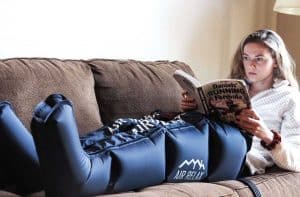Are you leaving fitness on the table?
If you’re not taking proper recovery measures, then YES!
But, what exactly does recovery mean?
To start, there is a lot of confusion when it comes to the term “recovery”.
Sure, we all know to grow as runners we must adequately recover between sessions. But, what is the best practice to do so?
Do we need to take time completely off of running? Should we take more easy days between hard workouts? What about during an actual workout?
In this article, I’m going to walk you through ways to effectively incorporate recovery within workouts, between quality sessions, and on the days you take off of running!
The Two Types of Recovery
To simplify, let’s break down the two types of recovery: complete and active.
1. Complete Recovery
Complete recovery occurs when runners participate in no form of physical activity.
I find this fits best into a runner’s program after a hard race or an intensive workout session.
Often, runners who push themselves to the max may need a complete recovery day to fully repair damage to the mind and body.
Here are a few ways to implement complete recovery into your program:
After Training Blocks
Every training block requires time to refill mental and physical stores.
Just as much as we want to push our bodies to new heights, we must also provide the body with rest periods allowing us to reach even higher for our next race build-up.
For many runners I work with, this seems counterintuitive.
“How can I get better if I’m not running,” they ask.
“But, I’m going to lose all the fitness I gained,” they say.
However, the truth is, without periods of complete recovery, progress becomes limited. Often, if recovery is ignored entirely, a decline in performance will soon be present.
To progressively get faster year-after-year, runners need to build in weeks of complete recovery between races.
Complete recovery helps the mind and body hit reset and allows you to reflect, reframe your goals, and tackle your next training block with fire!
It’s okay to lose a little bit of fitness!
If you play your cards right, fitness lost at the beginning of your plan will blossom into the best performances you’ve ever seen. But, you have to be patient and trust in yourself.
Within Your Week
Many runners take at least one day completely off of exercise each week.
For most, running every day of the week isn’t sustainable.
In my earlier years as a runner, I couldn’t handle 7 days a week of running. Running every day was draining. Add in the fact that I didn’t understand how to take an easy day, and you’d see how I found myself on the fastest train to burnout!
So, as we all do, I learned from trial and error.
I learned to respect my body, and instead of putting that weight of “I have to run EVERY SINGLE DAY”, I gave myself a day off every 7 to 14 days.
By doing so, I met all my goals that year, and more importantly, I avoided the dreaded burnout I was so accustomed to.
Don’t just take my word for it!
Even 5-time Olympian, Bernard Lagat took a day off each week.

Throughout his extensive career, Lagat always left a day off each week to restore his mind and body.
To give 100% to training each week, the day of rest wasn’t just a want, it was a need to ensure he could race hard all year long.
This mindful and patient approach to training led to a healthy and undoubtedly successful career.
You can do the same. Hard work comes at a cost! Be sure to account for your days of hard work with the necessary recovery for growth.
Post Race
Races inflict a great deal of damage on the body.
The longer the race, the more damage the body inherits.
Jumping back too quickly into vigorous training after a race will often make matters worse.
The results vary, from extended periods of fatigue to even injury.
I believe we can all relate. I’ve tried jumping back too quickly after a half marathon or marathon and found myself in an energy hole I was unable to dig myself out of.
It’s tough because your mind WANTS it, but your body can’t afford it.
As a general rule of thumb, I like to take a day of recovery for every 10k raced.
This means after racing a half marathon, I will ALWAYS take a day of complete recovery, and at least an additional day to recover “actively”(more on that next!).
2. Active Recovery
In some cases, complete recovery isn’t ideal.
Yes, we all need complete recovery, but often, a day of active recovery can better serve the body!
Active recovery promotes greater blood flow into muscles, which helps alleviate stress, reduces muscle soreness, and flushes out fatigue-inducing byproducts.
We can even go the extra mile and include active recovery within workouts.
I often receive the question, “What should I do during my rest periods?”.
Most have no clue what to do. They walk, stand, or perhaps jog around a little.
I can’t blame them. If I didn’t know any better, I would think the rest meant COMPLETE REST, too.
But, there are better options! HOW we recover during these periods can result in FASTER overall recovery and the prevention of fatigue.
The more you resist fatigue from building up, the faster (and longer) you will run!
Let’s break down how to best do it!
Within Workouts
What I love most about active recovery is it can be molded to fit ANY workout.
I almost always recommend active recovery between reps. This means you are running, or at the minimum, jogging, between your hard efforts.
Very rarely do I recommend standing rest or walking rest for my athletes.
Why?
For most distance runners, I don’t feel we need gut-wrenching sessions that require standing or walking recovery!
Even if I have my runners performing 200 or 400-meter repeats, there is always a JOG recovery between them. This keeps the sessions aerobic (even at a fast pace!), and it prevents a runner from trying to prove themselves during their reps.
As workouts and races get longer, the recovery periods receive even more emphasis.
To become stronger, faster, runners, we have to improve endurance. A MAJOR component of building endurance is becoming proficient at resisting the build-up of byproducts contributing to fatigue.
Yes, lactate is a part of this, but it’s not only lactate causing fatigue.
We can become more proficient at resisting fatigue by turning up the dial during our recovery sets.
Instead of walking, standing, or jogging, rest periods become steady. You no longer take your foot completely off the gas. You simply pull back just enough to “recover” and still hit your paces for the following reps.
Most runners find this incredibly difficult.
Most runners have a WEAKNESS in this area!
So, how do we fix weaknesses? We TRAIN them!
Here are a few workouts I incorporate that help to resist fatigue and increase endurance:
- 15 x 1 minute at 10k pace, 1 minute at Marathon pace + 20 to 40
- 4 x 2 Miles w/ .5 mile “Steady” between
- 4 Miles of 400 meters at 5k pace, 1200 meters at Marathon pace
Between Quality Sessions
To get the most from your hard days of training, recovery is essential.
I prefer to recover actively.
By running easy (Zone 2), you can effectively speed up the process of recovery while still giving your body an incentive to develop aerobically. It’s a win-win!
These days must be TRULY easy to obtain these benefits.
So, try your best to refrain from pushing the pace (even if you want to!!).
I find these days are best served running with others. If you’re like me, you naturally want to push it when you’re alone. Running with a buddy can allow the run to be conversational, relaxing, and in-line with the goals of a recovery run.
Non-running Days
If you decide not to run, cross-training is a wonderful alternative to capture the benefits of active recovery without the added stress of running.

With cross-training, you allow yourself to “de-load” from the forces of running, while still giving your muscles a hit of nutrient-dense blood flow signaling repair!
For more on the topic of cross-Training, check out our all-in-one guide to help you recover faster, avoid injury, and improve your aerobic capacity.
Conclusion
Learning how to recover is one of the most important factors of successful running. Not just today, but running over a lifetime.
Your success is determined not only by how hard you can work but by how efficiently you can recover.
Whether that is complete recovery or active recovery, understanding why, how, and when to implement each will make an impact on every inch of progress you make.

